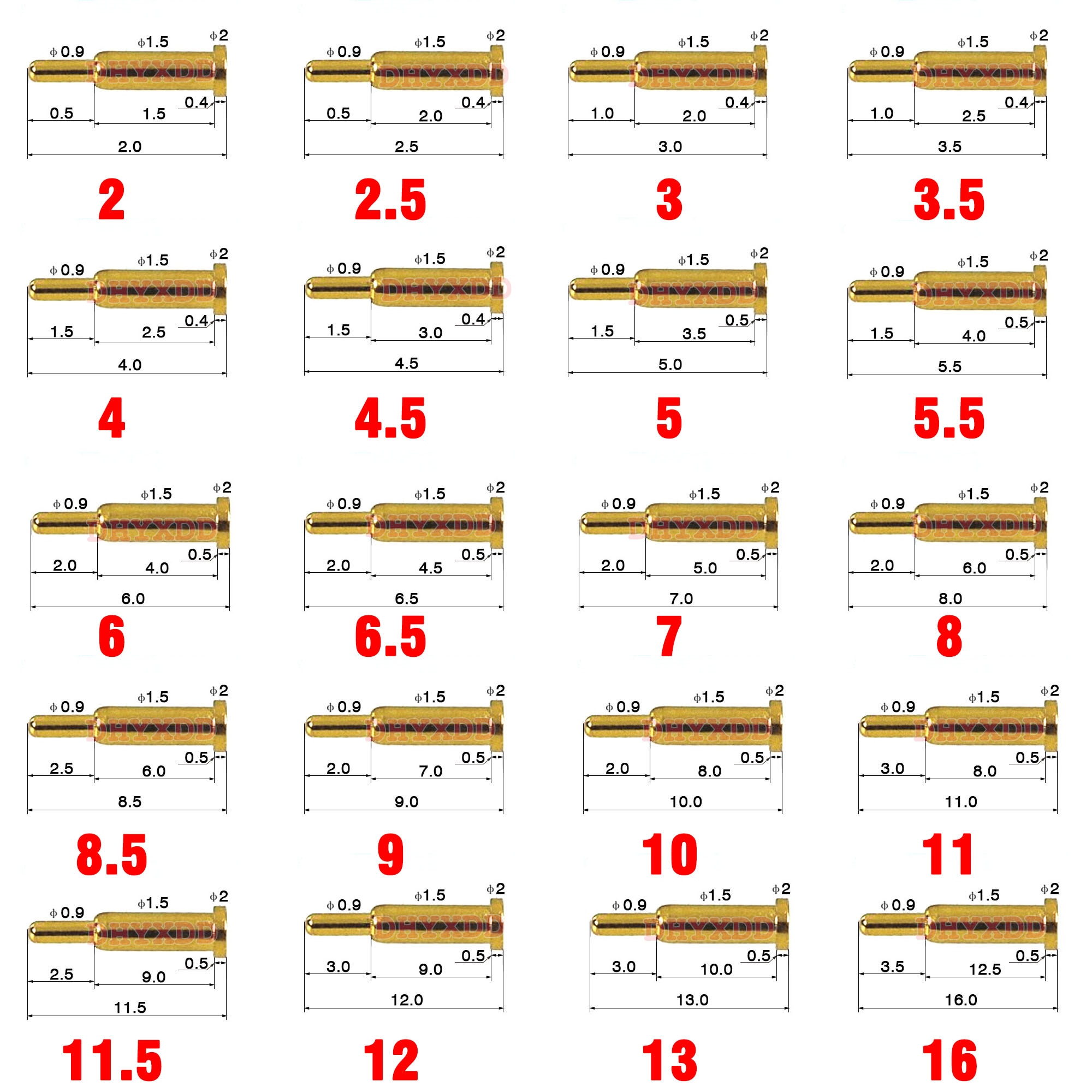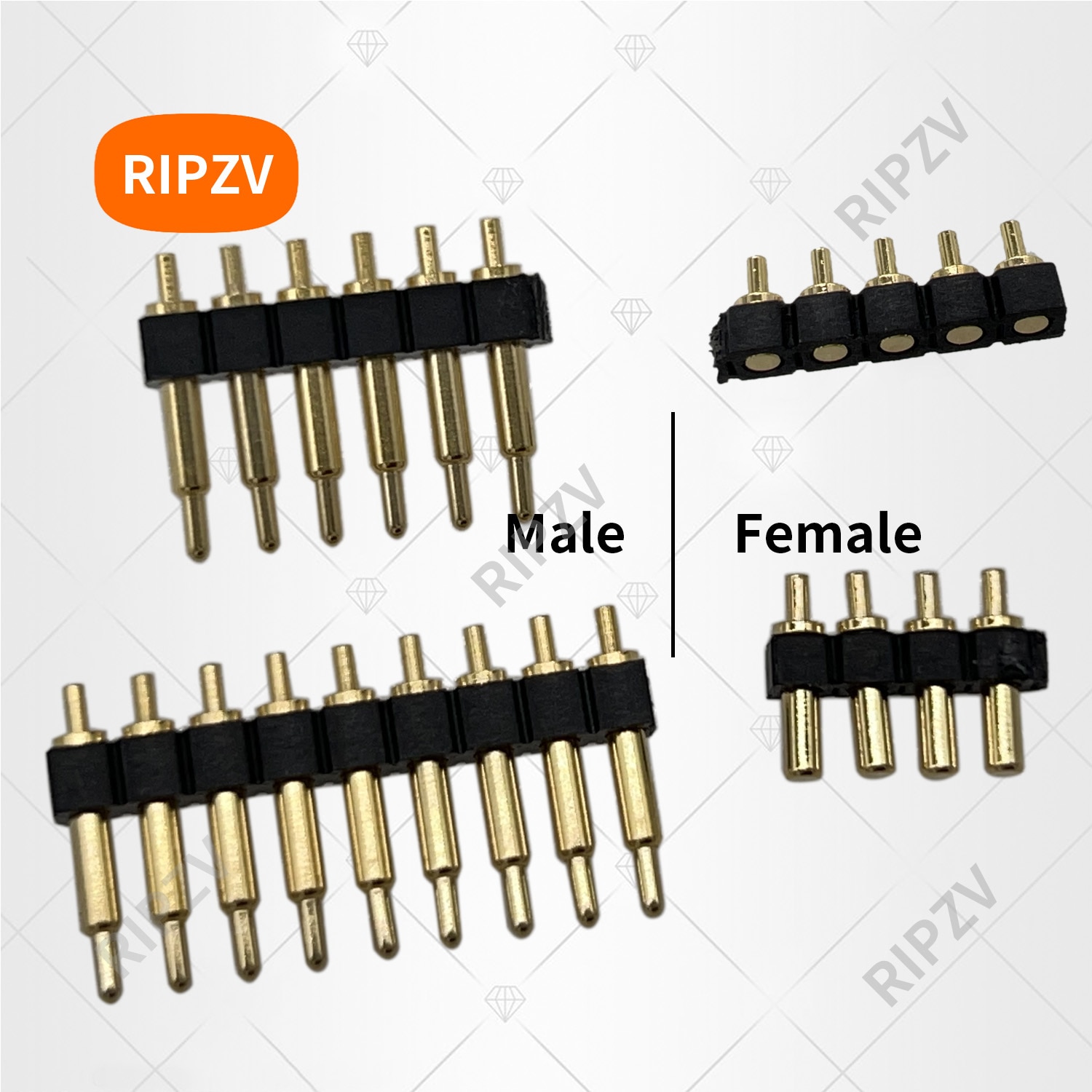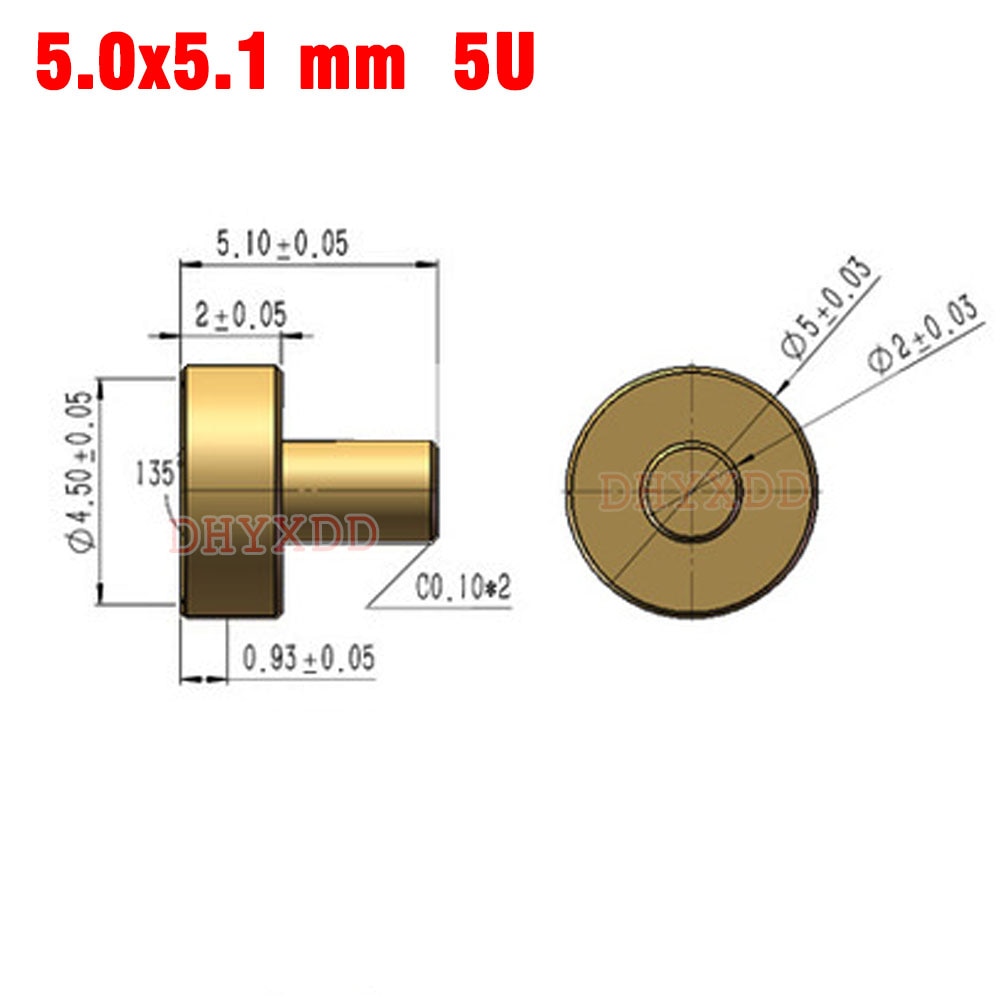BASE MATERIALS
The choice of test probe and spring contact base materials is highly dependent on the performance demands of each individual component in the assembly, as well as the final assembled product, in it’s application and end use environment.
1. PLUNGERS AND BARRELS
Phosphor Bronze is a choice for barrel material due to its excellent wear property. “phos-bronze” is a very good electrical conductor, easy to machine and will accept all plating types.
Nickel Silver has been proven over decades in international standard probes and many custom designs as a good electrical conductor which provides excellent dimensional repeatability, especially when formed using a deep-draw process.
Brass is commonly used in spring contacts for passive tip styles and for machined barrels. The high percentage of copper in brass alloys makes it an ideal electrical conductor for product interconnect applications. Brass, however, is too soft for aggressive tip styles which prevents it for being used for most test probes which are rated for much higher cycle life.
- Steel is used for practically all aggressive tip styles used for test probes. Steel provides durable and reliable UUT/DUT contact due to a high degree of hardness. Heat treated steel maintains good tip sharpness during use to provide long cycle life, even in demanding applications.
- Beryllium Copper (BeCu) is used often for both spring contacts and test probes. BeCu is an excellent electrical conductor and is easily machined and hardened and provides a good compromise between the properties of brass and steel. The relatively high percentage of copper in BeCu alloys enable it to be an ideal electrical conductor, while the smaller percentage of Beryllium allows the base material to be hardened for long term use and durability.
- Nickel silver (NiAg) is commonly used for forming receptacles and the barrels and has high tensile strength. This allows for high aspect ratio tubes to be formed. Higher aspect ratio tubes (barrels and receptacles) allow for fine pitch and larger spring volumes to be designed in. Fine features, such as press-rings, crimps, and detents can also be incorporated.
- Bronze is also used for receptacles and the barrels. Much like nickel silver, it also features a high tensile strength, and elasticity for high aspect ratios and fine features.
- HyperCore™ is a base material offered by Xcerra which provides you with longer life as there is no plating required. It offers high durabiity for plungers also offers very good chemical resistance, and has a hardness range of 400 – 600 HV, which prevents contamination build up on points and edges. It is ideal for aggressive tip styles, and is only used on semiconductor probe styles.
2. SPRINGS
- Beryllium Copper (BeCu)
- Music Wire is used primarily because of its high tensile strength and excellent fatigue life. Music wire springs can withstand high-load stresses compared to other materials, which makes it well suited for cyclic applications.
- Stainless Steel of varying alloys can be considered the highest possible quality spring material and is used for the more extreme high and low temperature ranges.
3. WIRE GAUGE REFERENCE
American Wire Gauge (AWG) Cable / Conductor Sizes and Properties
| AWG | Diameter [inches] |
Diameter [mm] |
Area [mm2] |
Resistance [Ohms / 1000 ft] |
Resistance [Ohms / km] |
Max Current [Amperes] |
Max Frequency for 100% skin depth |
| 0000 (4/0) | 0.46 | 11.684 | 107 | 0.049 | 0.16072 | 302 | 125 Hz |
| 000 (3/0) | 0.4096 | 10.40384 | 85 | 0.0618 | 0.202704 | 239 | 160 Hz |
| 00 (2/0) | 0.3648 | 9.26592 | 67.4 | 0.0779 | 0.255512 | 190 | 200 Hz |
| 0 (1/0) | 0.3249 | 8.25246 | 53.5 | 0.0983 | 0.322424 | 150 | 250 Hz |
| 1 | 0.2893 | 7.34822 | 42.4 | 0.1239 | 0.406392 | 119 | 325 Hz |
| 2 | 0.2576 | 6.54304 | 33.6 | 0.1563 | 0.512664 | 94 | 410 Hz |
| 3 | 0.2294 | 5.82676 | 26.7 | 0.197 | 0.64616 | 75 | 500 Hz |
| 4 | 0.2043 | 5.18922 | 21.2 | 0.2485 | 0.81508 | 60 | 650 Hz |
| 5 | 0.1819 | 4.62026 | 16.8 | 0.3133 | 1.027624 | 47 | 810 Hz |
| 6 | 0.162 | 4.1148 | 13.3 | 0.3951 | 1.295928 | 37 | 1100 Hz |
| 7 | 0.1443 | 3.66522 | 10.5 | 0.4982 | 1.634096 | 30 | 1300 Hz |
| 8 | 0.1285 | 3.2639 | 8.37 | 0.6282 | 2.060496 | 24 | 1650 Hz |
| 9 | 0.1144 | 2.90576 | 6.63 | 0.7921 | 2.598088 | 19 | 2050 Hz |
| 10 | 0.1019 | 2.58826 | 5.26 | 0.9989 | 3.276392 | 15 | 2600 Hz |
| 11 | 0.0907 | 2.30378 | 4.17 | 1.26 | 4.1328 | 12 | 3200 Hz |
| 12 | 0.0808 | 2.05232 | 3.31 | 1.588 | 5.20864 | 9.3 | 4150 Hz |
| 13 | 0.072 | 1.8288 | 2.62 | 2.003 | 6.56984 | 7.4 | 5300 Hz |
| 14 | 0.0641 | 1.62814 | 2.08 | 2.525 | 8.282 | 5.9 | 6700 Hz |
| 15 | 0.0571 | 1.45034 | 1.65 | 3.184 | 10.44352 | 4.7 | 8250 Hz |
| 16 | 0.0508 | 1.29032 | 1.31 | 4.016 | 13.17248 | 3.7 | 11 k Hz |
| 17 | 0.0453 | 1.15062 | 1.04 | 5.064 | 16.60992 | 2.9 | 13 k Hz |
| 18 | 0.0403 | 1.02362 | 0.823 | 6.385 | 20.9428 | 2.3 | 17 kHz |
| 19 | 0.0359 | 0.91186 | 0.653 | 8.051 | 26.40728 | 1.8 | 21 kHz |
| 20 | 0.032 | 0.8128 | 0.518 | 10.15 | 33.292 | 1.5 | 27 kHz |
| 21 | 0.0285 | 0.7239 | 0.41 | 12.8 | 41.984 | 1.2 | 33 kHz |
| 22 | 0.0254 | 0.64516 | 0.326 | 16.14 | 52.9392 | 0.92 | 42 kHz |
| 23 | 0.0226 | 0.57404 | 0.258 | 20.36 | 66.7808 | 0.729 | 53 kHz |
| 24 | 0.0201 | 0.51054 | 0.205 | 25.67 | 84.1976 | 0.577 | 68 kHz |
| 25 | 0.0179 | 0.45466 | 0.162 | 32.37 | 106.1736 | 0.457 | 85 kHz |
| 26 | 0.0159 | 0.40386 | 0.129 | 40.81 | 133.8568 | 0.361 | 107 kHz |
| 27 | 0.0142 | 0.36068 | 0.102 | 51.47 | 168.8216 | 0.288 | 130 kHz |
| 28 | 0.0126 | 0.32004 | 0.081 | 64.9 | 212.872 | 0.226 | 170 kHz |
| 29 | 0.0113 | 0.28702 | 0.0642 | 81.83 | 268.4024 | 0.182 | 210 kHz |
| 30 | 0.01 | 0.254 | 0.0509 | 103.2 | 338.496 | 0.142 | 270 kHz |
| 31 | 0.0089 | 0.22606 | 0.0404 | 130.1 | 426.728 | 0.113 | 340 kHz |
| 32 | 0.008 | 0.2032 | 0.032 | 164.1 | 538.248 | 0.091 | 430 kHz |
| 33 | 0.0071 | 0.18034 | 0.0254 | 206.9 | 678.632 | 0.072 | 540 kHz |
| 34 | 0.0063 | 0.16002 | 0.0201 | 260.9 | 855.752 | 0.056 | 690 kHz |
| 35 | 0.0056 | 0.14224 | 0.016 | 329 | 1079.12 | 0.044 | 870 kHz |
| 36 | 0.005 | 0.127 | 0.0127 | 414.8 | 1360 | 0.035 | 1100 kHz |
| 37 | 0.0045 | 0.1143 | 0.01 | 523.1 | 1715 | 0.0289 | 1350 kHz |
| 38 | 0.004 | 0.1016 | 0.00797 | 659.6 | 2163 | 0.0228 | 1750 kHz |
| 39 | 0.0035 | 0.0889 | 0.00632 | 831.8 | 2728 | 0.0175 | 2250 kHz |
| 40 | 0.0031 | 0.07874 | 0.00501 | 1049 | 3440 | 0.0137 | 2900 kHz |
PLATING MATERIALS
Plating materials are used to plate spring contacts and test probe components. Your choice of plating material will depend highly on your application and the intended function.
- Hard Gold provides excellent electrical performance for low-resistance applications, and provides the a very high level of chemical resistance. Gold typically has a hardness range of 150 – 200 HV, and is resistance to oxidation.
- Rhodium is a very hard corrosion resistant plating material. It is a preferred plating when maximum tip life is preferred.is extremely resistant to abrasion, has a hardness range of 600 – 1000 HV, but it is very brittle. Therefore, this plating material is not suitable for aggressive tip styles in conjunction with high spring forces. Rhodium is used when plunger tips are required to be especially durable.
- Chemical Nickel is a relatively hard plating and is used on probes as a barrier plate, and for its very good chemical resistance. Nickel only plating is not as conductive as the precious metals and is generally a low cost method of plating.
- Primeguard is a very hard plating option offered by Xcerra and is only used on Semiconductor probes to extend life and cleaning cycles on 100% tin or palladium based applications.
- Aurun is a gold-alloy plating material which was developed by Ingun especially for test probes. It has very good chemical resistance and a hardness range of 300 – 350 HV. It is used for aggressive tip styles to test “no-clean” and/or un-washed PC boards.
- LFRE is a proprietary hard plating alloy offered by Cohu (formerly Everett Charles, Osty Barton, Xcerra). Used on lead-free (RoHS) PCB boards and contact points. Approx. 5 times harder than gold plating to extend tip lifetime. Less prone for solder transfer on 100% Tin applications.
In general, plating materials are used to enhance conductivity, contact integrity, and contact reliability. Most plating materials are hard, durable, and provide low resistance values.



 1pcs 3.0mm Pitch SMT DIP ...
1pcs 3.0mm Pitch SMT DIP ...  1pcs Male / Female Spring...
1pcs Male / Female Spring...  1Pcs Pogo Pin Spring Need...
1Pcs Pogo Pin Spring Need...